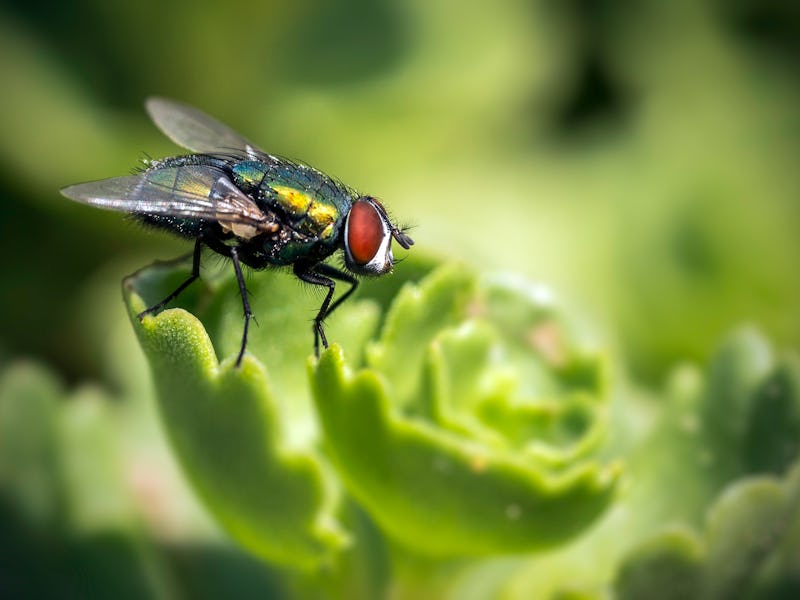Lady Flies Are Sexiest When It's Sunny
Building the ideal fly trap from the science of fly flirting.

Flies are the bane of summer existence. Fly swatting is rarely a hit and almost always a miss. But with research published Monday that suggests green bottle lady flies are more inclined to mate when the weather’s nice, there’s hope for a fly-free future.
Female flies capitalize on lots of natural light by beating their wings to make the light flash at a frequency that communicates to males their age, sex, and — maybe — current mating status.
Researchers studied distinct wing-flash frequencies among flies of different ages and sexes.
Turns out males are most attracted to the frequencies of “free-flying young females”: female flies that capitalize on lots of natural light by beating their wings to make the light flash at a frequency that communicates to males their age, sex, and — maybe — current mating status. Male flies are, in turn, responding to the signals they’re putting out there with overlarge eyes that capture this frequency, according to the research, which was published Monday in the journal BMC Biology.
U up?
All this flashing means that female flies have finally lent us a lens to understanding how to build the ultimate fly trap.
“We understood that they were doing this before, but we never understood why,” says co-author Michael Hrabar. “There are already existing traps [for mosquitoes etc.] that flash, but they’re flashing at the wrong frequency. Determining the specific frequency could lead to optimization of the trap.”
We’ve known for decades that insects prefer flashing lights to steady lights; they demonstrate a consistent preference for fluorescent lights over incandescent ones, as the former pulse at 120 Hz — not a frequency deliberately optimized for insects, just more recognizable to them than the alternative — while incandescent filaments steadily glow. The researchers believe that insects besides flies use these same signaling mechanisms, which is good news for our bug-trapping efforts.
Filming the flies 100 at a time, the researchers found that a wing-flash frequency of 178 Hz — the one most characteristic of young females — was more attractive to male flies than any other. Comparing sunlit days to cloudy ones allowed them to conclude that natural light is what facilitates the females’ subsequent mating signals. Overcast days equal reduced mating activity and fewer flies trying to flirt annoyingly with their wings.
Abstract
Background
Flies have some of the most elaborate visual systems in the Insecta, often featuring large, sexually dimorphic eyes with specialized “bright zones” that may have a functional role during mate-seeking behavior. The fast visual system of flies is considered to be an adaptation in support of their advanced flight abilities. Here, we show that the immense processing speed of the flies’ photoreceptors plays a crucial role in mate recognition.
Results
Video-recording wing movements of abdomen-mounted common green bottle flies, Lucilia sericata, under direct light at 15,000 frames per second revealed that wing movements produce a single, reflected light flash per wing beat. Such light flashes were not evident when we video-recorded wing movements under diffuse light. Males of L. sericata are strongly attracted to wing flash frequencies of 178 Hz, which are characteristic of free-flying young females (prospective mates), significantly more than to 212, 235, or 266 Hz, characteristic of young males, old females, and old males, respectively. In the absence of phenotypic traits of female flies, and when given a choice between light emitting diodes that emitted either constant light or light pulsed at a frequency of 110, 178, 250, or 290 Hz, males show a strong preference for the 178-Hz pulsed light, which most closely approximates the wing beat frequency of prospective mates.
Conclusions
We describe a previously unrecognized visual mate recognition system in L. sericata. The system depends upon the sex- and age-specific frequencies of light flashes reflecting off moving wings, and the ability of male flies to distinguish between the frequency of light flashes produced by rival males and prospective mates. Our findings imply that insect photoreceptors with fast processing speed may not only support agile flight with advanced maneuverability but may also play a supreme role in mate recognition. The low mating propensity of L. sericata males on cloudy days, when light flashes from the wings of flying females are absent, seems to indicate that these flies synchronize sexual communication with environmental conditions that optimize the conspicuousness of their communication signals, as predicted by sensory drive theory.